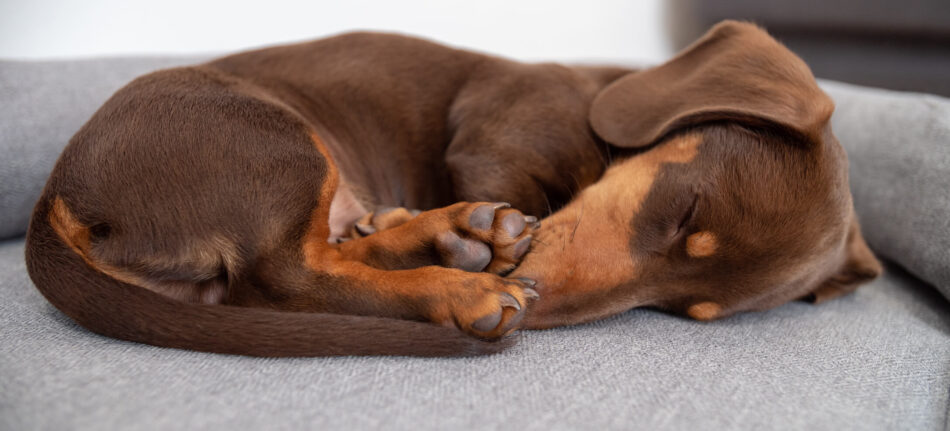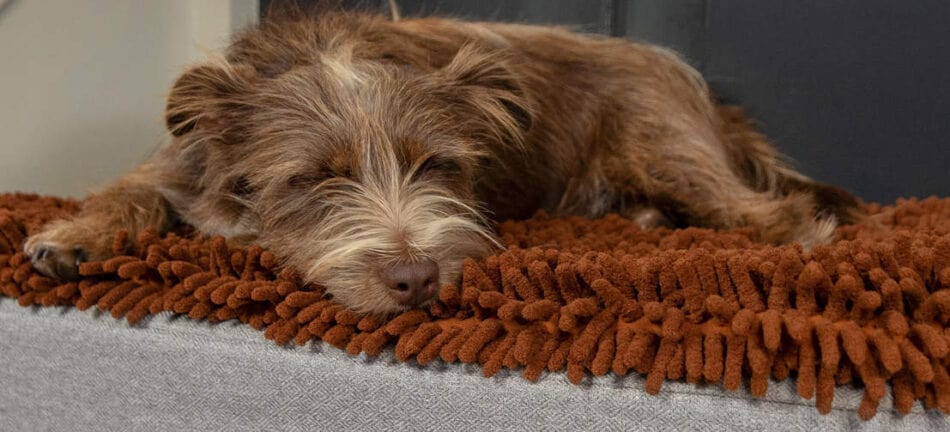8 Dog Sleeping Positions and What They Mean
A dog’s sleeping position can tell you many things about your pet that you don’t already know. Our guide to dog sleeping positions helps you identify the way your pup likes to slumber, and what this could indicate.
How much sleep do dogs need a day?
Dogs tend to sleep between 8 – 14 hours a day, whilst puppies need 18 – 20 hours. With so many hours resting in their dog bed, you’re likely to spot many dog sleeping positions whilst your pet is catching up on sleep! How your pet sleeps is just one way to read your dog’s body language, and could help you connect better with your pup.
8 different dog sleeping positions
We’ve put together 8 of the most common sleeping positions for dogs and what they could indicate. From health problems, to demonstrating their comfort around you, decode your puppy’s sleeping habits now.
Curled up in a ball
The position: This is a common sleeping position for wild dogs, who are much more vulnerable than our spoiled pet pooches. The vital organs are protected, the body heat is retained, and the dog can move quickly if needed.
What it means: Dogs that are in an unfamiliar location or experience something that is worrying them will often sleep in this position. To help ease your pet’s worries in new places, bring their familiar and comfy dog crate with you as a safe place for them to nap. However, if your dog prefers to roll up like a fox for nap time it doesn’t necessarily mean that he or she is worried or uncomfortable. They might just like being snuggled in.
Burrowed
The position: A burrowed dog sleeping position is when your pup has nuzzled their way under a blanket, pillows, or even a pile of clothes.
What it means: When opting for this dog sleeping position it shows your pet is looking for comfort or security. If you find your dog is searching for ways to calm themselves down, such as this sleeping position, a comforting dog blanket could help ease anxieties.
Sleeping on their side
The position: The most common sleeping position for dogs is on their side with the legs pointing straight out. Sometimes dogs will fall asleep in a different position, but as soon as the muscles relax and the dog starts to dream, they will automatically roll onto their side.
What it means: This dog’s sleeping position exposes their vital organs. So a dog who prefers to sleep on its side is likely relaxed and comfortable and feels safe with his or her surroundings.
As the legs are free to move in this sleeping position, it is likely that you will see the dog’s legs twitch and kick as they dream.
If your dog favors this position, make sure that their bed is big enough to accommodate their whole body, including the outstretched legs.
Super pup pose
The position: In this dog sleeping position, your pup is on its tummy, with all four legs stretched out. This is very common with puppies who need regular naps, but also always want to be ready to play at any given moment. This is because it’s very easy to get up and going upon waking.
What it means: The Super Pup is almost completely limited to napping; very few dogs spend a whole night in this dog sleeping position. It’s also much more common with smaller dog breeds like terriers and toy breeds, possibly because their limbs are shorter.
On the back, legs up in the air
The position: If your dog is cold, they will curl up into a ball. In a similar way, exposing the belly and spreading out will cool your dog down. Exposing the tummy, where the fur is much thinner, as well as showing the sweat glands on the paws are two of your dog’s best tools to stay cool.
What it means: Comfortable as it may be, it is however a very vulnerable dog sleeping position. The vital organs are exposed, and it will take the dog much longer to get up and go in case of danger than if they had their legs on the ground. If your dog chooses this position even when it’s not boiling hot, it is likely that he or she feels extremely relaxed and comfortable.
Head raised
The position: If your dog is sleeping in a position with their head raised, they’re most likely using the side of a sofa, their dog bed, or even a cushion to prop them up.
What it means: If you find this is a common dog sleeping position for your pet – it could be a sign of dog illness such as breathing difficulties. Keep an eye out for any other symptoms such as fast breathing, and take your dog to a vet if you are concerned.
Close to a human or other pet
The position: Many dogs love falling asleep next to another living thing, preferably really, really close. This behavior comes from their time as puppies, before they could regulate their own body temperature and had to snuggle up to their siblings to stay warm.
What it means: Although grown dogs don’t need you (or the cat) as a heat source, they have come to associate sleeping next to something warm and breathing with comfort and security. You can be sure that your dog is completely relaxed in your company if he or she decides to sleep right next to you.
Lion’s pose
The position: The lion’s post dog sleeping position is when your pet sleeps with their head resting on their paws. Their back paws will be to one side of their body.
This position is similar to how many lion statues appear.
What it means: When in this dog sleeping position shows that your dog is catching up on sleep, but will be ready to play in seconds. They tend to not be in a deep sleep when lying in this dog sleeping position.
Helping your dog get a good night’s sleep
Ensuring your pet gets a good night’s rest is essential to keep them feeling their best and being ready to play or go on a walk. Ensuring you choose the right size dog bed for your pet could make them as comfy as possible at nap time. Providing them with a blanket could also give them extra comfort. For when the weather gets a little too hot, we recommend giving your pup a dog cooling mat which could help them drift off into a peaceful slumber.
Petcare with Omlet
Providing your beloved pet with all the things they need to enjoy being at home is vital. Our range of dog toys and dog treats can help you connect with your pet, as well as aid in training new puppies.
This entry was posted in Dogs

